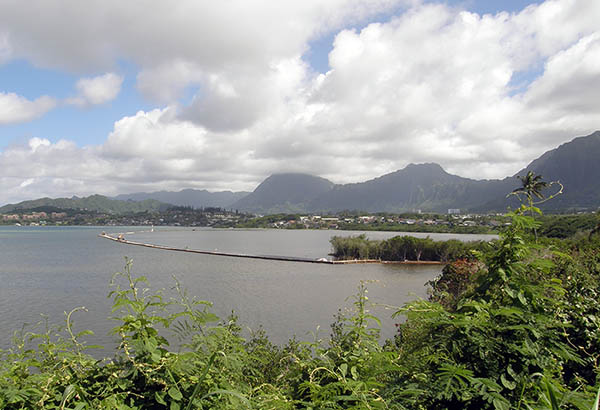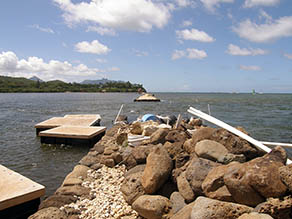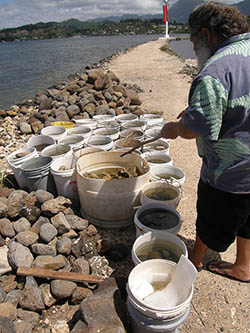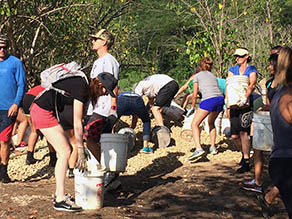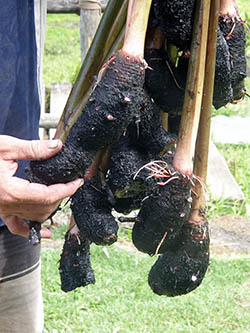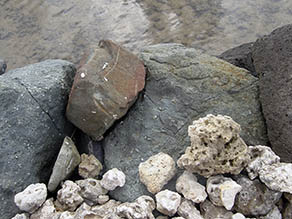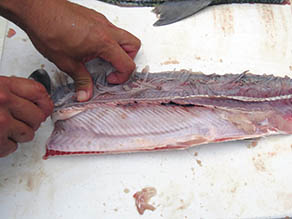 |
 |
 |
 |
||||||
|
|
|
|
|
|
|
|
|
|
 |
|
 |
|||||||||||
 |
View of He‘eia fish pond from the State Park. “When we first started doing things here,” Hi‘ilei says of He‘eia fish pond, “prior to us having an organization, there was a kūpuna [elder] by the name of Anakala Eddie Ka‘anana that came down. Not often, but he did come down, and we were harvesting the mangroves to build the hālau wa‘a at Ka Papa Lo‘i o Kanawai at University of Hawai‘i at Mānoa. And he quoted an old ‘ōlelo no‘eau, ‘ka li‘u o ka pa‘akai.’ Ka li‘u is the act of salting. Pa‘akai is the salt, in its physical form. Ka li‘u is what the salt does to preserve. “He was saying that there are these places that exist in Hawai‘i and elsewhere that were left here intentionally by our ancestors. Such places are just waiting for us—the descendants—to take up that work, dust those places off, and reawaken them, reinvigorate them. That they lay dormant, waiting for someone, waiting for the right person, waiting for us to come in and breathe life back into them.” Hi‘ilei folks tell their history of Paepae o He‘eia “There was a large puka [hole] in the wall created from a 1965 flood. There was a series of floods that happened during that time. The first flood of 1965 was February, and then the flood that impacted us here was May 2nd, 1965. The February flood caused a lot of devastation in the Kāne‘ohe area, so Kea‘ahala, Kapunahala area, all were flooded. May 2nd, 1965 caused a lot of devastation in He‘eia and Kahalu‘u. “The story was that the gates were all closed in the fishpond, and the floodwaters built up then came in, took out a portion of our mauka wall—a good section, like maybe 200 feet of our earthen wall—continued on through the fishpond and took out a 200-foot section of our makai wall where you see that A-frame out there. So for 50 years that puka has been a puka. Now when we talk about that area—now that it’s fixed—we try not to refer to it as ‘puka’ even though it’s really hard to do. “Mary Brooks had temporarily fixed the puka, but when we inherited the pond, it sort of was always a problem for us. We’re traditionalists to a certain extent in terms of the construction material used to restore the pond. We very much wanted to see only basalt stone and coral fill. So having concrete test cylinders as a temporary fix, that were already starting to shift and undermine itself. We knew that we wanted to repair it in its traditional alignment. Mary had done a dogleg which was great for her because at least she was able to get the fishpond to a point where she was able to cultivate fishing and limu in it. “We started thinking about permits and then it really took us about four and a half years to get the permits necessary to fix the hole in the wall. And then we got the permit in 2014, July of 2014. We started construction and we completed it in December of 2015. So one year later about, and now we have a functioning fishpond.” On rebuilding the hale on the fishpond walls “Maybe just five years ago there was a bunch of holes in this wall,” Keahi adds, “where fish were swimming in and out, and there was no regulation on what fish were in here and how long we could keep our mullets in here before they just wanted to leave one day out of these holes. Today there are no ocean exits from this pond except for the mākāhā that have gates in them, so we can fully contain our fish and now we can fully see that process.” “We see sections of rock wall that fall down over the course of several months,” Keli‘i says. “Individual rocks fall or slide off. We need a ton of work, and we need thousands of people down here every year because we are restoring something. Kind of like a new car: the better you maintain it, the less effort it takes. Just like your home garden. You let your garden go to the weeds and it takes a lot of effort again up front to get it up and running. But you maintain it, not too bad, twenty minutes a day. “If you don’t maintain the fishpond for two years, you have to put a lot of work to get it back up and running. But if you have constant maintenance going on, I don’t believe it would have taken more than a few families—maybe a little bit more than that because this is a large pond, 88 acres, but at least for the maintenance of the traditional infrastructure, I think a few families could have easily done that if there were some assignments.” Read about rebuilding the walls themselves “From our perspective, we who work here,” Hi‘ilei says, “this is a place of cultural practice. It is teaching us how to be 21st-century Native Hawaiians. And it’s really important for us to have places like this for us to practice a way of preserving the culture. And not so much the knowledge, because there really isn’t a whole lot of knowledge out there about how to take care of a fishpond. You can’t read an instruction manual. Maybe there’s other practices in Hawaiian culture where you could, but with fishponds, it’s people that are here actually doing the work: ‘ma ka hana a ‘ike’—‘in the doing is the knowing,’ and vice versa. The knowing really just throws more work on you, overtime. “From our perspective, that’s what this place provides. It’s this kīpuka. We talk about kīpuka on the Big Island as these pockets of forest that exist amidst a field of lava, where the species are impact there, all native, native birds go there. So there are these cultural kīpuka as well. It’s kind of like an oasis, these places where we can learn and tinker and problem solve. All the kinds of things that you’re not afforded to do outside of the walls and confines of the fishpond. “There are several places like this throughout the pae ‘āina, throughout Hā‘ena and Kawauinui, and that’s important because these are the places where the culture is alive and thriving. And then there’s how does the fishpond serve a role for the community. There are places for learning. Hi‘ilei explains the ahu (altar) and the wa‘a (canoe) at the pond “Captain Clay Bertelman with the Makali‘i voyaging canoe, he gets credit for saying ‘He wa‘a he moku, he moku he wa‘a.’ That your island is your canoe; your canoe is your island. These lessons apply here. We live on an island. I think it’s harder to do in a continental situation. But when that canoe leaves the shores of Hawai‘i, your community is there, your resources are there. They’re not infinite. They’re very much finite and it teaches you how be, how to live in the community, how to share, how to manage your resources, how to partition the work, how if something comes up you got to deal with it. You can’t run away from it, right? Because you’re in survival mode. You’re on a canoe. Same here: you know the lessons of the fishpond teach us similarly that we should all be thinking that way even if we live on a continent—maybe even more so if we live on a continent. “One of the most important lessons of the fishpond would be persistence and practice,” Keli‘i advises. “We are learning first-hand as we go. We may have, call it the DNA, call it the ancestral memories, ancestral wisdom that is in us, but either we haven’t had a chance to express it, or it hasn’t expressed itself in us until we were able to persist and then practice what we do at a particular place for an extended period of time. “I think in today’s world, in our society, in our economy, all around the world, we need to persist in places longer. We need to know our places better. It’s more than just, ‘I’ve lived in the same neighborhood for my whole life.’ I think it’s more than that, especially in the face of climate change—and for us on the islands, sea-level rise, things are changing, rain is changing, saltwater is intruding further inland and will continue to do that more than it ever has. “Our fate is intrinsically tied to knowing the places. Which brings me to my second one: knowing where your food comes from. Our fate is tied to that. For us here in Hawai‘i, we can’t continue to exist off of the containers that come, that bring 85% of the food that we eat on these islands. The local economy, which definitely does not have to include money, we try to have our own ahupua‘a economy of trade, of sharing, of giving. Those are the kind of things that are going to help us survive in the face of these changes and that’s what’s going to help us have abundance moving forward into the future. “And the only way we’re going to know that is by persisting and sitting, observing—noho papa: sitting, learning, knowing, understanding. I can honestly say that that was not my lifestyle before this, and it’s taken me years to get to the point to realize that, ‘Man, my kids really need to know this fishpond.’ They love to eat poi. They really need to know where poi comes from, and if we can’t grow it ourselves, then we need to be working with those farmers, those people who helped to put food on our table.” Read about poaching at the fish pond “So I think one of the lessons that the fishpond helps to teach those who come here once a week, once a month, or they might only come once in their life. Know your space, begin the process of understanding the environment around you, whether it be your home, your workplace, whatever. If you’re into eating locally, then participating in those places where your food comes from because that’s how our ancestors were able to do it for hundreds if not thousands of years on these islands with zero imports. Our answers and our future lie in the past. That’s how we’re going to survive on these islands into perpetuity, because our ancestors figured it out and this fishpond is a prime example of that. Keli‘i describes the fingerling project “I can only assume that this fishpond was not built right when somebody started living here in this geographic location. They said, ‘Oh yeah, it would be probably good to build a fishpond. That big, this big over here yeah you know make a wall.’ It took them a long time to figure out exactly when, where, how big to build a fishpond because of years, generations, of observations and then knowing this is a particularly productive area. We can use the resources that are around us to build it this big and in this fashion with the curve of the wall here. I can only assume that there was so much thought and detail that went into that and we need to get ourselves to that level, myself included, have a long way to go. “It takes generations. And then once you persist and you noho papa, then you practice, you practice, you practice. And not just like ‘practice makes perfect,’ but practice is you’re just doing it. You walking the walk. You might be somebody who just comes here once. Whatever that means to you, just practice. Find out your practice and do it, learn it, do it, continually do it, and pass that tradition on. “That’s one side of what I think the fishpond teaches us. And then the other side is food. Fishponds were built to feed. So being more aware and attached to where our food comes from and being responsible to it. The fishpond teaches us responsibility, true responsibility. Not responsibility to... ‘okay I got to be at work at 8 o’clock every morning.’ You got to be responsible to where your food comes from and to the ocean, and to the land because hey man, economies go up and down, stock market goes up and down, but if you can still put food on your table and you know how to grow food or you know how to gather food or you know how to trade, you know how to share food, those things. Other things can go away but our bodies, our human bodies, still got to eat and drink water. Those are like foundational to our survival. “So what does the fishpond teach us? Let’s know how to grow fish and let’s be responsible. Let’s make sure that our kids eat fish, that our grandkids eat fish, and they learn those practices as well too so that their grandkids can eat fish. So there’s a successional mindset to responsibility.”
|
 |
|
 |
Maintaining traditional uses of the land and sea is just part of replanting He‘eia's culture and values back into future generations.
|
 |
||
 |
|
 |
||

|
 |
||||
|
||||
Copyright 2019 Pacific Worlds & Associates • Usage Policy • Webmaster |
||||
